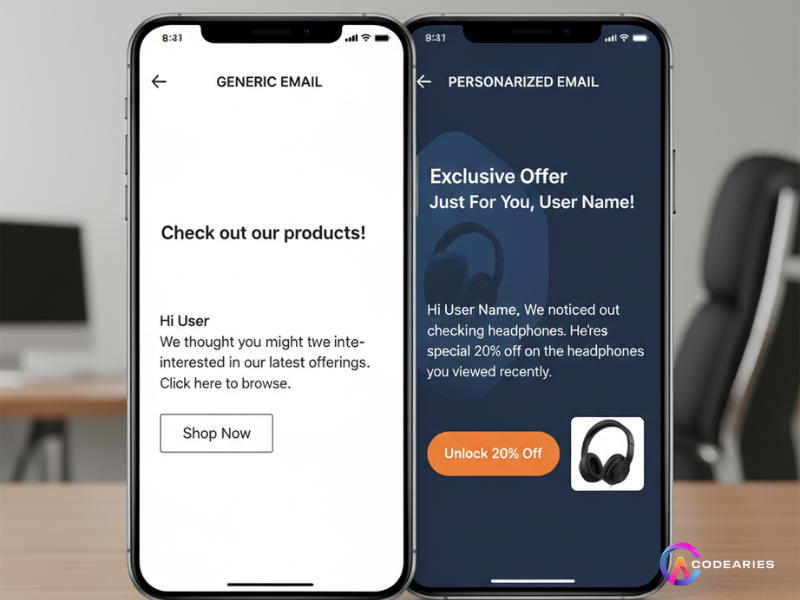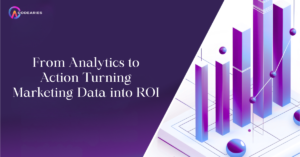In today’s highly competitive digital environment, standing out and connecting with customers is tougher than ever. Success depends on delivering marketing campaigns that feel personal, relevant, and timely. These campaigns must be tailored to each person’s preferences, behaviors, and context. This is exactly where hyper-personalization, supported by artificial intelligence (AI), is changing marketing strategies in 2025.
As AI improves and data-sharing systems develop, businesses gain new abilities to predict customer intent, generate content automatically, create dynamic offers, and build loyalty, all on a large scale and in real time.
This blog discusses how AI drives hyper-personalized marketing campaigns. It highlights successful use cases, the technologies involved, benefits, challenges, and how Codearies helps businesses maximize the potential of AI-driven personalization.
What is Hyper-Personalization?
Hyper-personalization goes further than traditional segmentation. It uses AI and real-time data to create tailored customer experiences. Unlike generic campaigns that target broad groups, hyper-personalization adjusts messaging, offers, and content based on a deep understanding of each user’s preferences, behaviors, and contextual signals.
Core ingredients include:
- Massive unified customer data (from web, apps, CRM, offline)
- Advanced AI models analyzing clickstreams, purchase history, interactions
- Real-time decision engines that adapt campaigns on the fly
- Automated marketing execution across email, SMS, social, and web
How AI Enables Hyper-Personalized Marketing
1. Data Integration and Customer Insights
AI-driven marketing platforms gather large, multi-channel datasets into customer data platforms (CDPs). This unifies scattered profiles. Machine learning models extract meaningful insights, from lifetime value estimates to moments of intent, enabling marketers to understand not just who customers are, but what they are likely to do next.
2. Predictive Analytics and Intent Modeling
Using historical and real-time data, AI predicts future behaviors such as purchase likelihood, churn risk, or product interest. Marketers can engage customers proactively with relevant messages before interest fades or competitors step in.
3. Dynamic Content Generation
Generative AI creates personalized copy, visuals, and video content tailored to different segments or even individual customers. It allows for the production of hundreds of campaign variations optimized for various audiences.
For example, AI can generate custom product descriptions, email subject lines, or social media posts, adjusting tone, length, and call-to-action based on user profile data.
4. Real-Time Campaign Optimization
AI systems track ongoing campaign KPIs and customer responses across channels. They automatically adjust timing, frequency, and creative elements to improve ROI. Methods like send-time optimization and multi-armed bandit testing help marketers reach users when they are most receptive.
5. Personalized Reward & Loyalty Programs
Instead of offering standard rewards, AI creates loyalty offers that resonate with each customer’s preferences and behaviors. This boosts engagement, retention, and average order value.
6. Omnichannel Orchestration
AI maintains consistent personalized experiences across all touchpoints, including email, mobile app, website, social media, offline stores, and call centers. This creates seamless journeys that unify brand messaging and user context.

Real-World Use Cases in 2025
- Amazon earns 35% of its revenue from AI-powered personalized recommendations. These recommendations consider browsing history, wishlist data, and demographics, making product discovery easy and engaging.
- Netflix’s content recommendation engine suggests movies and series based on each user’s viewing habits, watch time, and social trends, keeping engagement high.
- Starbucks combines purchase history with location data to send timely offers for favorite drinks when users are near stores, blending geofencing with AI.
- Spotify generates custom playlists, such as Discover Weekly, based on detailed listening patterns and mood cues, turning data into emotionally resonant experiences.
AI-driven chatbots integrated into platforms provide dynamic conversational marketing. They answer questions and suggest offers as part of the sales process.
Benefits of AI-Powered Hyper-Personalization
- Boosted Engagement: Tailored content captures attention and maintains interest.
- Improved Conversion Rates: Relevant offers prompt action, boosting sales.
- Enhanced Customer Loyalty: Personalized journeys build emotional connections.
- Cost Efficiency: Automation lowers the need for manual content creation and campaign management.
- Scalable Impact: Reach millions with individualized experiences that would be impossible to achieve manually.

Challenges to Consider
- Data Privacy & Consent: Compliance with regulations like GDPR and CCPA and ethical use of customer data is crucial.
- Model Transparency: Balancing AI complexity with clarity is important to maintain trust.
- Integration Complexity: Coordinating data across different systems requires a strong setup.
- Over-Personalization: Misguided personalization can alienate users or invade their privacy.
- Content Quality Control: AI-generated content needs oversight to ensure it matches the brand.
How Codearies Drives Hyper-Personalized Marketing Success
At Codearies, we work with businesses to unlock powerful AI-driven marketing capabilities tailored to your audience and goals. Our method combines technology, strategic insights, and hands-on engineering to enhance customer engagement.
What We Offer:
- Custom AI & ML Models: Create predictive analytics, segmentation, and intent engines based on your data.
- Generative Content Solutions: Implement scalable AI-driven copywriting, video creation, and social media content for different segments.
- Omnichannel Automation: Seamlessly orchestrate personalized campaigns across email, push, SMS, social, and web.
- Compliance & Security: Develop data handling and consent workflows that meet global regulations and build customer trust.
- Dashboard & Analytics: Monitor and report in real time to boost performance and adapt on the fly.
- Ongoing Optimization: Regularly retrain models, test campaigns, and integrate user feedback for continuous improvement.
Together, we help you create marketing systems that please users, drive conversions, and maintain a competitive edge
Frequently Asked Questions (FAQs)
How does AI improve marketing personalization compared to traditional methods?
AI processes vast datasets and identifies patterns that humans cannot see, allowing for real-time, detailed personalization at scale.
Can Codearies integrate AI personalization into my existing marketing tools?
Yes, we specialize in integrating AI with CRMs, CDPs, ESPs, and ad platforms seamlessly.
How do you handle customer data privacy and consent in AI marketing?
We create privacy-first systems, manage consent, anonymize data, and comply with GDPR, CCPA, and other regulations.
What industries benefit most from AI-powered hyper-personalization?
E-commerce, fintech, travel, media, SaaS, and retail are leading adopters that see strong ROI.
How long does it take to deploy an AI-driven personalization system?
Deployment usually takes between 8 to 16 weeks, depending on data volume, integration scope, and customization requirements.







